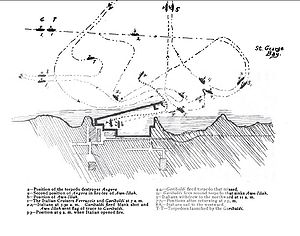| Battle of Beirut | |||||||
|---|---|---|---|---|---|---|---|
| Part of the Italo-Turkish War | |||||||
 A sketch of warship positions during the Battle of Beirut. | |||||||
| |||||||
| Belligerents | |||||||
|
|
| ||||||
| Commanders and leaders | |||||||
|
|
| ||||||
| Strength | |||||||
| 2 armoured cruisers |
1 corvette 1 torpedo boat | ||||||
| Casualties and losses | |||||||
| None |
1 corvette sunk 1 torpedo boat sunk 6 lighters sunk 49–55 killed (including 2–3 officers) 108 wounded (including 8 officers) | ||||||
| Civilian Casualties: 66 killed | |||||||
The Battle of Beirut was a naval battle off the coast of Beirut during the Italo-Turkish War. Italian fears that the Ottoman naval forces at Beirut could be used to threaten the approach to the Suez Canal led the Italian military to order the destruction of the Ottoman naval presence in the area. On 24 February 1912 two Italian armoured cruisers attacked and sank an Ottoman casemate corvette and six lighters, retired, then returned and sank an Ottoman torpedo boat.
As a result of the battle all Ottoman naval forces in the region were annihilated, thus ensuring the approaches to the Suez Canal were open to the Italians. Besides the naval losses, the city of Beirut itself suffered significant damage from the Italian warships.